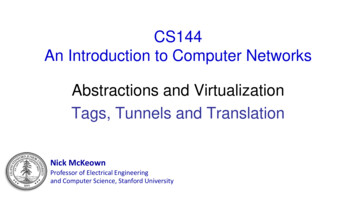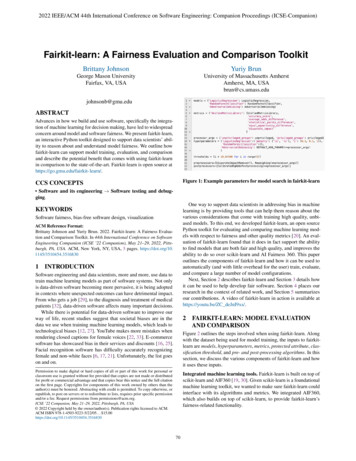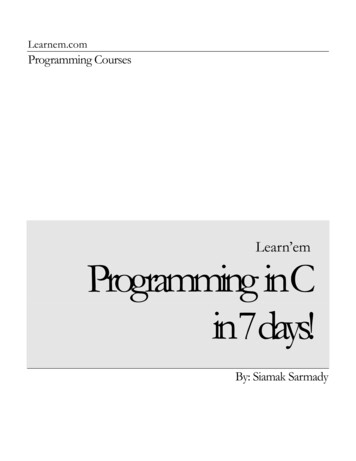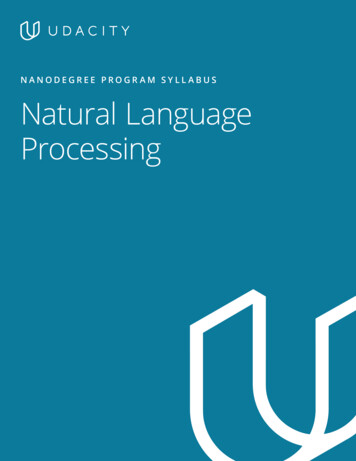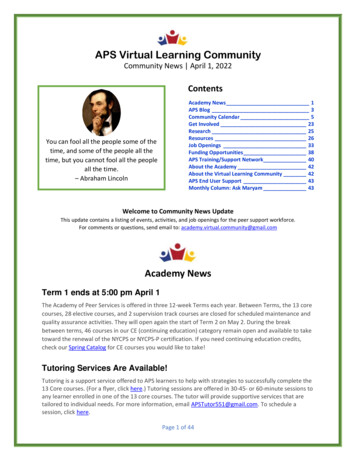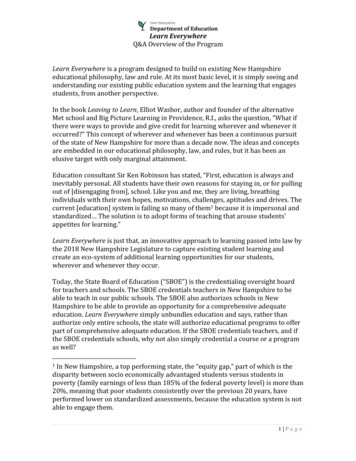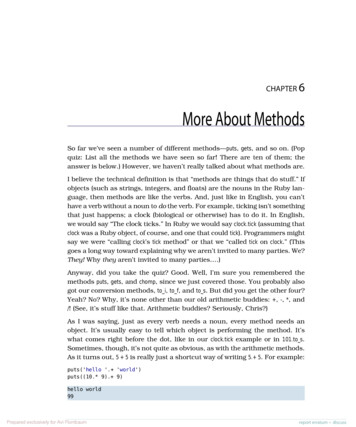
Transcription
CHAPTER 6More About MethodsSo far we’ve seen a number of different methods—puts, gets, and so on. (Popquiz: List all the methods we have seen so far! There are ten of them; theanswer is below.) However, we haven’t really talked about what methods are.I believe the technical definition is that “methods are things that do stuff.” Ifobjects (such as strings, integers, and floats) are the nouns in the Ruby language, then methods are like the verbs. And, just like in English, you can’thave a verb without a noun to do the verb. For example, ticking isn’t somethingthat just happens; a clock (biological or otherwise) has to do it. In English,we would say “The clock ticks.” In Ruby we would say clock.tick (assuming thatclock was a Ruby object, of course, and one that could tick). Programmers mightsay we were “calling clock’s tick method” or that we “called tick on clock.” (Thisgoes a long way toward explaining why we aren’t invited to many parties. We?They! Why they aren’t invited to many parties .)Anyway, did you take the quiz? Good. Well, I’m sure you remembered themethods puts, gets, and chomp, since we just covered those. You probably alsogot our conversion methods, to i, to f, and to s. But did you get the other four?Yeah? No? Why, it’s none other than our old arithmetic buddies: , -, *, and/! (See, it’s stuff like that. Arithmetic buddies? Seriously, Chris?)As I was saying, just as every verb needs a noun, every method needs anobject. It’s usually easy to tell which object is performing the method. It’swhat comes right before the dot, like in our clock.tick example or in 101.to s.Sometimes, though, it’s not quite as obvious, as with the arithmetic methods.As it turns out, 5 5 is really just a shortcut way of writing 5. 5. For example:puts('hello '. 'world')puts((10.* 9). 9)hello world99Prepared exclusively for Avi Flombaumreport erratum discuss
28 Chapter 6. More About MethodsIt isn’t very pretty, so we won’t ever write it like that; however, it’s importantto understand what is really happening.This also gives us a deeper understanding of why we can do 'pig'*5 but wecan’t do 5*'pig': 'pig'*5 is telling 'pig' to do the multiplying, but 5*'pig' is telling 5to do the multiplying. 'pig' knows how to make 5 copies of itself and add themall together; however, 5 will have a much more difficult time of making 'pig'copies of itself and adding them together.And, of course, we still have puts and gets to explain. Where are their objects?In English, you can sometimes leave out the noun; for example, if a villainyells “Die!” the implicit noun is whomever he is yelling at. In Ruby, if I sayputs 'to be or not to be', the implicit object is whatever object you happen to be in.But we don’t even know how to be in an object yet; we’ve always been insidea special object Ruby has created for us that represents the whole program.You can always see what object you are in by using the special variable self.Watch this:puts selfmainIf you didn’t entirely follow all of that, that’s OK. The important thing to getfrom all this is that every method is being done by some object, even if itdoesn’t have a dot in front of it. If you understand that, then you’re all set.6.1Fancy String MethodsLet’s learn a few fun string methods. You don’t have to memorize them all;you can just look up this page again if you forget them. I just want to showyou a small part of what strings can do. In fact, I can’t remember even halfof the string methods myself—but that’s fine, because you can find greatreferences on the Internet with all the string methods listed and explained.(I will show you where to find them in Chapter 15, Beyond This Fine Book,on page 123.) Really, I don’t even want to know all the string methods; it’s kindof like knowing every word in the dictionary. I can speak English just finewithout knowing every word in the dictionary. (And isn’t that really the wholepoint of the dictionary? You don’t have to know what’s in it.)Our first string method is reverse, which returns a reversed version of thestring:FF1 SPOILER ALERT!(From back whenfinal used to meansomething.)var1 'stop'var2 'deliver repaid desserts'var3 '.TCELES B HSUP A magic spell?'Prepared exclusively for Avi Flombaumreport erratum discuss
Fancy String Methodsputsputsputsputsputsputs potsstressed diaper reviled?lleps cigam A PUSH B SELECT.stopdeliver repaid desserts.TCELES B HSUP A magic spell?As you can see, reverse doesn’t change the original string; it just makes a newbackward version of it. That’s why var1 is still 'stop' even after we called reverseon it.Another string method is length, which tells us the number of characters (including spaces) in the string:putsnameputsputs'What is your full name?' gets.chomp'Did you know there are ' name.length ' characters''in your name, ' name '?'❮ What is your full name? Christopher David Pine❮ # TypeError: can't convert Fixnum into String Uh-oh! See? There it is! It’s an easy mistake to make. Anyway, if you didn’tknow to be on the lookout for this error, you can still figure that the problemmust have happened sometime after the line name gets.chomp, since I was ableto type my name. See whether you can figure it out.The problem is with length: it gives us an integer, but we want a string. That’seasy enough; we’ll just throw in a .to s (and cross our fingers):putsnameputsputs'What is your full name?' gets.chomp'Did you know there are ' name.length.to s ' characters''in your name, ' name '?'You probably thinkthat I made thatmistake on purpose,since I’m obviouslysuch a fabulousprogrammer that I’mwriting a book on it.You were thinkingthat, right?Well never mind.❮ What is your full name? Christopher David Pine❮ Did you know there are 22 charactersin your name, Christopher David Pine?No, I did not know that. Note: 22 is the number of characters in my name,not the number of letters (count ’em). I guess we could write a program thatPrepared exclusively for Avi Flombaumreport erratum discuss
30 Chapter 6. More About Methodsasks for your first, middle, and last names individually and then adds thoselengths together—hey, why don’t you do that? Go ahead, I’ll wait.Did you do it? Right on.Well, unless your name is Bjørn or Håvard, in which case you had someproblems. Ruby is expecting only ASCII characters (basically the stuff youcan type on an American keyboard—the A in ASCII stands for American). Itis possible to use any character in any language, but it requires some extrawork and is just more advanced than what we’re going to cover.So, a number of string methods can also change the case (uppercase andlowercase) of your string. upcase changes every lowercase letter to uppercase,and downcase changes every uppercase letter to lowercase. swapcase switchesthe case of every letter in the string, and finally, capitalize is just like downcase,except it switches the first character to uppercase (if it’s a letter).letters 'aAbBcCdDeE'puts letters.upcaseputs letters.downcaseputs letters.swapcaseputs letters.capitalizeputs ' a'.capitalizeputs bBcCdDeEAs you can see from the line puts ' a'.capitalize, the capitalize method capitalizesonly the first character, not the first letter. Also, as we have seen before,throughout all of these method calls, letters remains unchanged. I don’t meanto belabor the point, but it’s important to understand. Some methods dochange the associated object, but we haven’t seen any yet, and we won’t forsome time.The last of the fancy string methods we’ll look at do visual formatting. Thefirst, center, adds spaces to the beginning and end of the string to make itcentered. However, just like you have to tell the puts method what you wantit to print and you have to tell the method what you want it to add, youhave to tell the center method how wide you want your centered string to be.Prepared exclusively for Avi Flombaumreport erratum discuss
Fancy String Methods 31So if I wanted to center the lines of a poem, I would do it like this:I wanted to line upthe .center line widthpart, so I added thoseextra spaces beforethe strings. This is justbecause I think it isprettier that way.Programmers oftenhave strong feelingsabout codeaesthetics, and theyoften disagree aboutthem. The more youprogram, the moreyou will come intoyour own style.line width 50puts('Old Mother Hubbard'.center(line width))puts('Sat in her cupboard'.center(line width))puts('Eating her curds and whey,'.center(line width))puts('When along came a spider'.center(line width))puts('Who sat down beside her'.center(line width))puts('And scared her poor shoe dog away.'.center(line width))Old Mother HubbardSat in her cupboardEating her curds and whey,When along came a spiderWho sat down beside herAnd scared her poor shoe dog away.Hmmm I don’t think that’s how that nursery rhyme goes, but I’m too lazyto look it up. Speaking of laziness, see how I stored the width of the poem inthe variable line width? This was so that if I want to go back later and makethe poem wider, I have to change only the first line of the program, insteadof every line that does centering. With a very long poem, this could save mea lot of time. That’s the kind of laziness we want in our programs.About that centering you may have noticed that it isn’t quite as beautifulas a word processor would have done. If you really want perfect centering(and maybe a nicer font), then you should just use a word processor. Rubyis a wonderful tool, but no tool is the right tool for every job.The other two string-formatting methods we’ll look at today are ljust and rjust,which stand for left justify and right justify. They are similar to center, exceptthat they pad the string with spaces on the right and left sides, respectively.Let’s take a look at all three in action:line width 40str '-- text --'puts(str.ljust( line width))puts(str.center(line width))puts(str.rjust( line width))puts(str.ljust(line width/2) str.rjust(line width/2))-- text --- text --- text --Prepared exclusively for Avi Flombaum-- text --- text --report erratum discuss
326.2 Chapter 6. More About MethodsA Few Things to Try Angry boss. Write an angry boss program that rudely asks what you want.Whatever you answer, the angry boss should yell it back to you and thenfire you. For example, if you type in I want a raise, it should yell back likethis:WHADDAYA MEAN "I WANT A RAISE"?!? YOU'RE FIRED!! Table of contents. Here’s something for you to do in order to play aroundmore with center, ljust, and rjust: write a program that will display a table ofcontents so that it looks like this:Table of ContentsChapter 1:Chapter 2:Chapter 3:6.3Getting StartedNumbersLetterspage 1page 9page 13Higher Math(This section is optional. Some of it assumes a fair degree of mathematicalknowledge. If you aren’t interested, you can go straight to Chapter 7, FlowControl, on page 37, without any problems. However, a quick scan of this sectionmight come in handy.)There aren’t nearly as many number methods as there are string methods(though I still don’t know them all off the top of my head). Here we’ll look atthe rest of the arithmetic methods, a random number generator, and the Mathobject, with its trigonometric and transcendental methods.6.4Modulus, much likeinteger division,might seem bizarre,but it is actually reallyuseful, often whenused with integerdivision.More ArithmeticThe other two arithmetic methods are ** (exponentiation) and % (modulus).So if you want to say “five squared” in Ruby, you would write it as 5**2. Youcan also use floats for your exponent, so if you want the square root of 5, youcould write 5**0.5. The modulus method gives you the remainder after divisionby a number. So, for example, if you divide 7 by 3, you get 2 with a remainderof 1. Let’s see it working in a repared exclusively for Avi Flombaumreport erratum discuss
Random Numbers 33252.23606797749979211From that last line, we learn that a (nonleap) year has some number of weeks,plus one day. So if your birthday was on a Tuesday this year, it will be on aWednesday next year. You can also use floats with the modulus method.Basically, it works the only sensible way it could but I’ll let you play aroundwith that.I have one last method to mention before we check out the random numbergenerator: abs. This method simply returns the absolute value of the number:puts (5-2).absputs (2-5).abs336.5Random NumbersRuby comes with a pretty nice random number generator. The method to geta randomly chosen number is rand. If you call rand just like that, you’ll get afloat greater than or equal to 0.0 and less than 1.0. If you give it an integerparameter (by calling rand(5), for example), it will give you an integer greaterthan or equal to 0 and less than 5 (so five possible numbers, from 0 to 4).Let’s see rand in action:puts randputs randputs 99999999999999999999999999999999999))puts('The weatherman said there is a')puts(rand(101).to s '% chance of rain,')puts('but you can never trust a weatherman.')Why all theparentheses? Well,when I have severallevels of things goingon, all on a single lineof code, I like to addparentheses to makesure the computerand I agree on justwhat is supposed 74922352112Prepared exclusively for Avi Flombaumreport erratum discuss
34 Chapter 6. More About he weatherman said there is a67% chance of rain,but you can never trust a weatherman.Note that for the weatherman example I used rand(101) to get numbers from 0to 100 and that rand(1) always returns 0. Not understanding the range of possiblereturn values is the biggest mistake I see people make with rand, even professional programmers, and even in finished products you can buy at the store.I once had a CD player that if set on Random Play, would play every song butthe last one. (I wonder what would have happened if I had put in a CD withonly one song on it.)Sometimes you might want rand to return the same random numbers in thesame sequence on two different runs of your program. (For example, I usedrandomly generated numbers to generate the worlds in Civilization III. If Ifound a world that I really liked, I’d save it, run tests on it, and so on.) In orderto do this, you need to set the seed, which you can do with srand:srand uts(rand(100))puts ''srand uts(rand(100))69669766966976It will do the same thing every time you seed it with the same number. If youwant to get different numbers again (like what happens if you never use srand),then just call srand, passing in no parameter. This seeds it with a really weirdPrepared exclusively for Avi Flombaumreport erratum discuss
The Math Object 35number, using (among other things) the current time on your computer, downto the millisecond.6.6The Math ObjectFinally, let’s look at the Math object. They say a code example is worth 1,000words:Math::PI is actually ::E**2))puts((1 Math.sqrt(5))/2)a variable; it’s aconstant. It doesn’tvary. Remember howI said that variables inRuby have to startwith a lowercaseletter? Constantsstart with anuppercase letter. Themain difference isthat Ruby complainsif you try to reassigna 1.61803398874989The first thing you noticed was probably the :: notation. Explaining the scopeoperator (which is what that is) is beyond the uh scope of this book. Nopun intended. I swear. Suffice it to say, you can use Math::PI like it were anyother variable.As you can see, Math has all the features you would expect a decent scientificcalculator to have. And, as always, the floats are really close to being the rightanswers but not exact; don’t trust them further than you can calculate them.Prepared exclusively for Avi Flombaumreport erratum discuss
It isn't very pretty, so we won't ever write it like that; however, it's important to understand what is really happening. This also gives us a deeper understanding of why we can do 'pig'*5 but we can't do 5*' pig': 'pig'*5 is telling ' ' to do the multiplying, but 5*'pig' is telling 5 to do the multiplying. 'pig' knows how to make 5 copies of itself and add them



